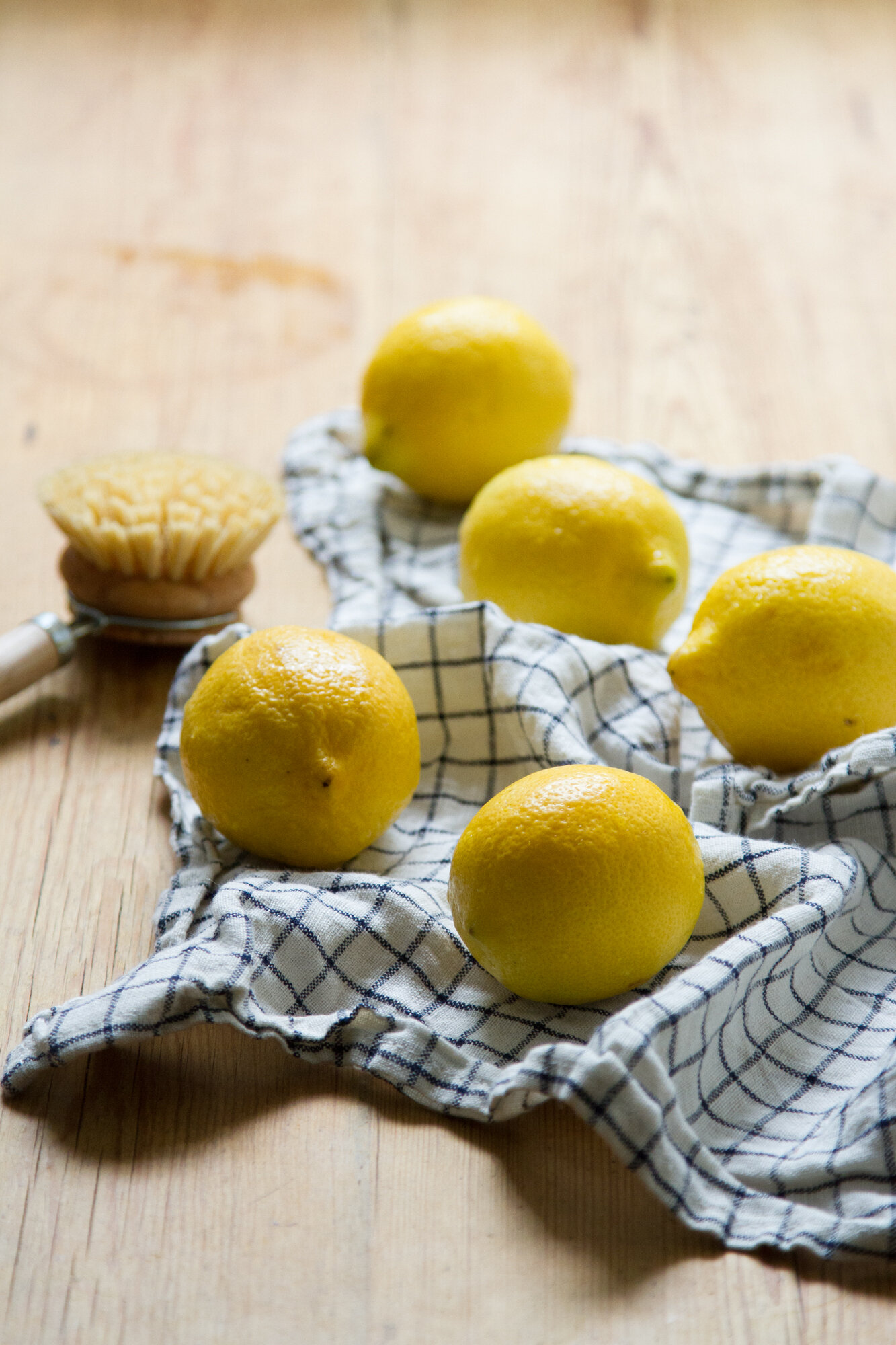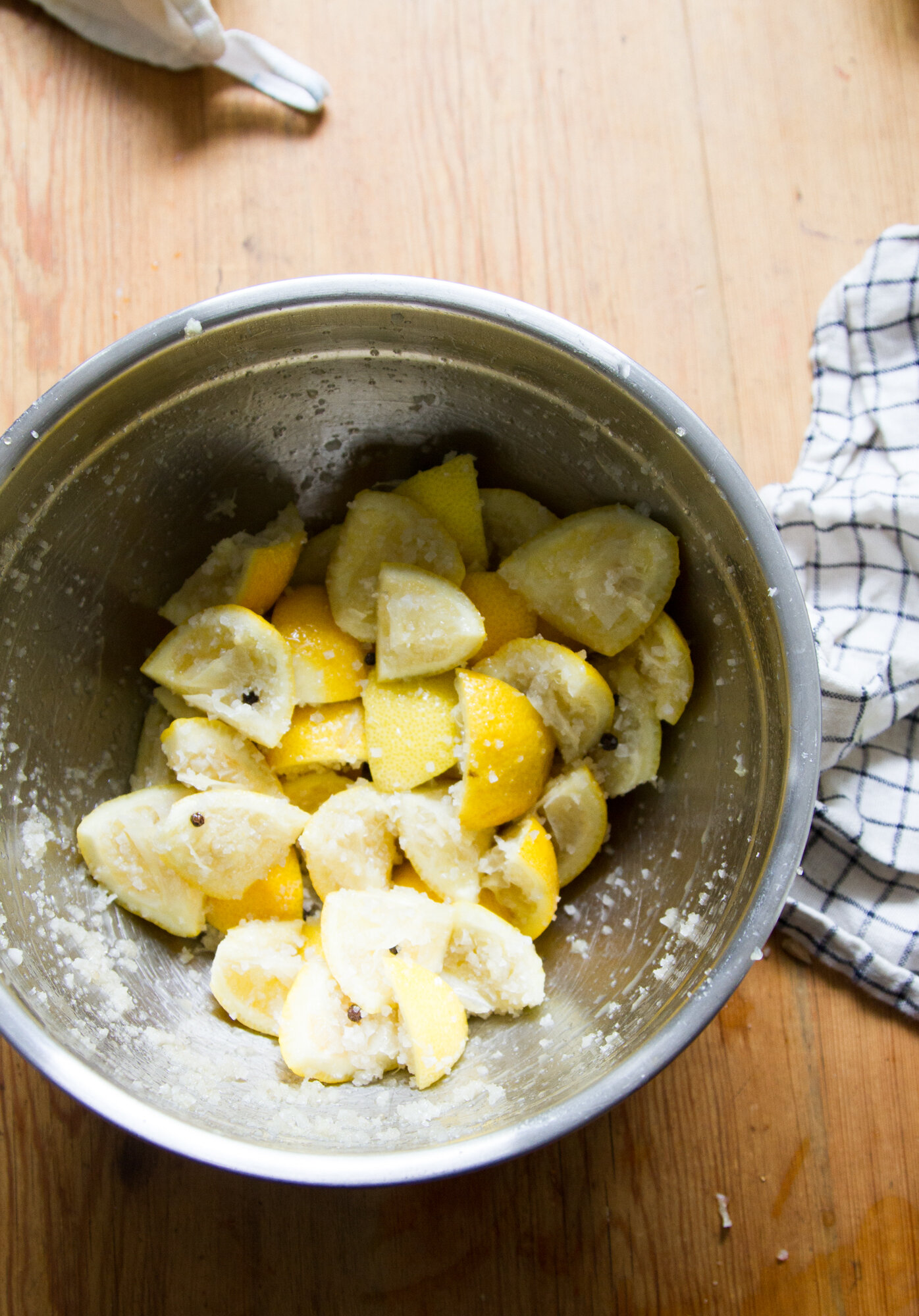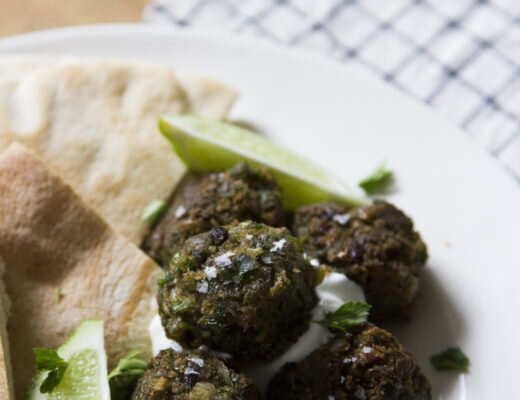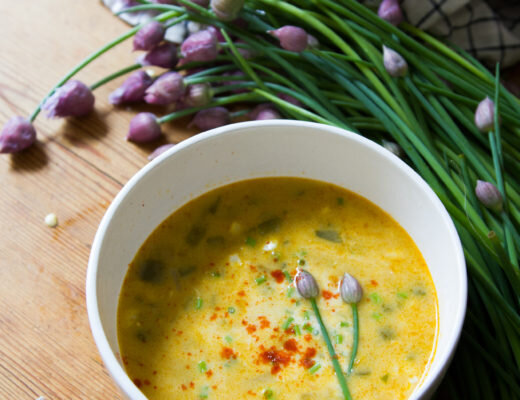
Waste Not is a collaboration with my friend, Carrie King. The premise is simple: Carrie, a food writer and editor, shares a recipe highlighting at least one particular way that we can curb food waste. I make it at home, take a bunch of pictures, and share it with everyone here.
This is perhaps my favorite kind of recipe: a guideline for something that’s easy to make and delicious to eat, but most importantly, something that makes a whole host of other things taste infinitely better. When dinner looks lackluster, a jar or preserved lemons in the fridge can make it shine. So far we’ve dipped into our jar of preserved lemons for adding to whole wheat pasta with wilted spinach and for making a quick and delicious veggie dip from yogurt. This weekend they’ll be perfect for adding a bright zing to chickpea salad sandwiches.
From Carrie:
When life gives you lemons, make lemonade, but then preserve the rinds!
So, I’ll just start by saying that true preserved lemons take at least 3-4 weeks to make. You start with a bunch of whole lemons, some spices if you want, and through the magic of lacto-fermentation, just like sauerkraut and kimchi, you end up with delicious preserved lemons. They can be stored for a long time, there for the taking whenever you want to gussy up a dish. Rinse them, dice them, skin and all, and you’re good to go! The longer process of making real preserved lemons is worth it, especially to have on hand in the fall and winter months in chillier climes where fresh pops of flavor and color become scarce as the temperatures drop. Not to mention, a jar of preserved lemons looks real pretty on a kitchen shelf.
A mainstay in many North African and Middle Eastern cuisines, they are best known for the tangy pop of flavor they instantly bring to stews like tagines. If you’re interested in making a big batch that will keep for up to a year, I’d direct you to any of Paula Wolfert’s recipes as she is an undisputed expert. But if you’re at all like me—unapologetically into preserving with a little more instant gratification—then this is a quick way to get some of the preserved lemon flavor benefits while also cutting back on everyday food waste.
If you find yourself with two or three or four or five (!) squeezed lemons after making a big batch of lemonade or lemon curd or ceviche or whatever else uses lots of citrus juice, you don’t have to discard the rinds. Simply slice or dice them (discard the seeds) and rub them with a salt/sugar mixture. Put the salted lemon rinds and flesh into the pint jar, along with any last drops of juice. If you let them sit out for a day at room temperature then it will help the process along and then you can shake it up and store the jar in the fridge for the next week or two. The preserved lemons can be added to brighten up stews and braised meats, or chopped into relishes loaded with fresh herbs and capers or olives to top simple grilled fish or chicken or veggies. Or you could mix slices into a grain salad with feta or goat cheese and arugula or spinach. Preserved lemons can become part of a pesto for pasta or to slather on a fancy panini. In other words, anywhere you might otherwise use lemon, you can incorporate a bit of your preserved rinds!
Quick ‘Preserved’ Lemons
4-5 whole or juiced unwaxed organic lemons (or any number will do!)
½ cup kosher salt (if using just 1 or 2 squeezed rinds, you’ll need only a few tablespoons)
1 Tablespoon sugar
1 teaspoon black peppercorns

In a medium bowl, mix together salt, sugar, and peppercorns.
Scrub any whole lemons. Trim any hard stem ends and remove seeds if necessary.
Quarter any whole lemons lengthwise, squeeze any juice into the bowl with salt mixture.
Cut all lemon rinds/flesh into 2-inch pieces.
Transfer chopped lemons to bowl and rub thoroughly with the salt/sugar mixture.
Transfer to a pint jar with a tight lid, scraping all juice and salt into jar. Tightly seal. Let sit at room temp for a day, shake, then store in fridge for up to a week or two.

// NOTES:
This is a guideline! The amount of salt/sugar you’ll need depends on factors like how many lemons you’re using, their size, and how juicy they are. The idea is to reduce food waste here, so the same process can also be done with just one already squeezed lemon if that’s all you have! (You could use the loose ratio of 1 1/2 tablespoons salt and 1/2 tbsp sugar per lemon if you’re looking to scale the recipe up or down.) Dice or slice, generously rub with about 2 tablespoons of the salt/sugar combo, pack into a smaller jar with a bit more sugar/salt on the bottom and use within a week or two.
I suggest unwaxed, organic lemons because you are eating the whole rind. Give them a good scrub before using.
Thanks to Carrie King for writing this post and developing the recipe. When Carrie’s not encouraging me in tiny-apartment cooking adventures, she’s a food writer and editor. Her cookbook work includes Breakfast, Lunch, Dinner….Life with Missy Robbins and The Chef Next Door with Amanda Freitag. She has contributed to Gather Journal and Life & Thyme and works as recipe editor at Marley Spoon and Dinnerly. Thanks to culinary school and lots of time spent in kitchens, both professional and home, she can cook just about anything, but usually just wants a few couple few slices of pizza.
For the curious:
Our checked napkin is from Fog Linen.
Our stainless steel bowl is from this set (a tiny apartment kitchen must-have).
My candlestick and pitcher are from Notary Ceramics. James made the candle!
What about you guys? How do you eat your preserved lemons?




21 Comments
I love this column! After a recent budget overhaul, I have realized that we spend a LOT of money on food (relatively speaking for a middle income family in the US). So I love the idea of wasting less of it. One question, can you accumulate rinds in your freezer before starting a batch of preserved rinds? I have done this for sugared orange peels, so would think you could for preserved lemons too…
Hi Maryann! I agree – food isn’t cheap! So, it’s nice to squeeze out every last drop from your weekly haul. I think frozen rinds could be ok, but the texture might be impacted. The water inside the lemons freezes as the rinds thaw and cure they might become a bit mushy. Also, since freezing is already a way of preserving food for longer, I wouldn’t expect a thawed batch of rinds to last as long after curing. Maybe it could be for an almost immediate use like a dinner party or bbq!
Thanks Carrie!
I roll lemons in a meat grinder with sugar. Together with bones and skin. I use everywhere: lemonade, tea, pies, sandwiches, sauces and just like that, a snack.
Any tips on locating unwaxed lemons? Are organic lemons usually free of wax? I’ve seen this in other recipes and wasn’t sure how exactly to tell.
Lots of citrus is waxed, but it is possible find bags of unwaxed organic lemons (if they’re sold in bulk, there’s usually a tag indicating if they’re waxed or not!) But! You can also wash your lemons with hot water and take a clean vegetable brush to them to get wax off. I also use just a drop off the same multi-purpose Sal’s Suds that I use for everything as a vegetable wash!
Love this. Just made the same thing this week! I’ve been eating them in salad with candied ginger using this recipe: https://food52.com/recipes/74361-small-oven-s-green-salad-with-preserved-lemon-and-candied-ginger. Addicted to it!
Epiphany: Use the whole entire lemon!! I just learned two weeks ago that you can chop your whole entire lemon (sans seeds) and make a wonderful lemon salsa verde! Absolutely game-changing, to me, anyway! I used this recipe from Bon Appetit: https://www.bonappetit.com/recipe/lemony-salsa-verde and I served it with fresh scallops from the farmer’s market. So delicious! Would preserved lemons would be too sweet to use in this way? In any case, the whole rind element blew my mind. Growth mindset!
Excuse me for using this forum to ask a formatting question. I have your blog front and center in my Top Sites page, and recently (~2 or 3 weeks) even when I load, re-load and re-load with Plug-Ins, I am often “stuck” with older images in the catalog of Top Sites (still lovely but images and test from several letters earlier.) Have you changed how you post them, or is it something I’m not doing or correcting in my browser? (Safari)
Hey Ellen, Sorry to say I’m not totally following here. I have a feeling this might have to do with needing to clear your browser cache? Can’t think of anything on this end that would be impacting it!
Preserved lemons are a great secret ingredient! I make batches of preserved lemons when Meyer lemons are in season, and can them in a water bath. Favorite uses for them are diced into gazpacho where their salty/citrus/ floral nature shines, and also diced into a onion, garlic, tomato, dried fruit, and chicken braise where they add zing and depth.
I’m not a huge lemon fan, so we rarely ever use them. But I do make Lemonade occasionally during the summer. Usually I just throw the rinds into the garden after thoroughly making sure they’re deseeded… But I may just give this a try next time. Trying something new never hurts- and who knows. Might just be the one other way I enjoy them, lol.
This sounds lovely and I’ve wanted to try doing something like this for a while but quick question do you clean off the salt mixture before eating them?
Hey Elise! Yes, just give them a quick rinse before you use them to get rid of excess salt.
Love this idea, as it is so creative! I find myself bookmarking all of your posts belonging to the “waste not” series for future reference. I’d never heard of ‘preserved’ lemons until now, but they are now on my TBC (to be cooked) list.
This looks like a brilliant recipe – quick, easy and tasty – I am definitely going to give this a try. I hate waste and am always looking out for tips, so thank you!
This is a great idea! I hate waste, and would love to find ways to eat every part of the fresh food that we get. And sounds fantastic! Tangy, salty flavor is my favorite! Thank you for the great series Erin and Carrie!
okay. i’m in love with that candle holder. . . but perspective is an issue for me 🙂
is yours the medium or large size?
i’m debating between the two.
thanks!!
I think it’s the large!
thank you! 🙂
Can we preserve Mandarin (Kinnow) peels same way.
Comments are moderated.